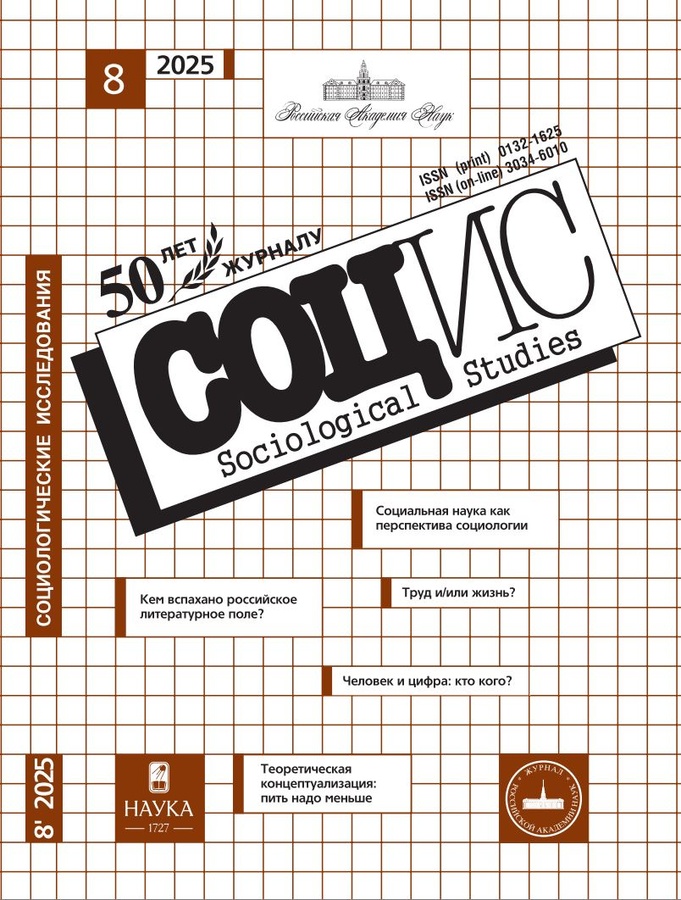Перемены в после-школьных траекториях молодежи: социальная дифференциация
- Авторы: Чередниченко Г.А.1
-
Учреждения:
- Институт социологии ФНИСЦ РАН
- Выпуск: № 9 (2023)
- Страницы: 51-62
- Раздел: Статьи
- URL: https://kazanmedjournal.ru/0132-1625/article/view/661907
- DOI: https://doi.org/10.31857/S013216250027362-1
- ID: 661907
Цитировать
Полный текст
Аннотация
Актуальный тренд в после-школьных траекториях молодежи – перераспределение спроса от вузов к колледжам (ссузам) – анализируется раздельно по формам обучения высшего образования с учетом социальных характеристик потребителей. Показано, что спад поступающих в вузы идет за счет заочного и не затрагивает очное обучение. Под воздействием институциональных изменений средней и высшей школы (усиления иерархии и селективности, введения ЕГЭ) продолжается социальная консолидация двух треков: (1) дающего доступ посредством ЕГЭ к очному обучению в вузах и (2) открывающего путь – через транзит среднего профессионального образования – к заочной подготовке в высшей школе. Представители первого – в большой мере выходцы из семей, наделенных экономическими и социокультурными ресурсами, а вторые – из более массовых групп трудящихся и рабочих. Переключение спроса от высшего к среднему профессиональному идет у части молодежи второго трека от программ и направлений обучения высшей школы (преимущественно для «старого» сервисного сектора), которые утратили функцию «социального лифта» и рентабельность на рынке труда, в пользу актуальных массовых сервисных профессий в области IT и др., предоставляемых в ссузах. Одновременно меняется спрос в направлении большей рентабельности программ заочного обучения в вузах. Выявляются новые черты социального неравенства в образовании.
Об авторах
Галина Анатольевна Чередниченко
Институт социологии ФНИСЦ РАНРоссийская Федерация, Москва
Список литературы
- Абанкина И., Белова Ю., Зиньковский К. и др. Есть ли у педагогов альтернатива репетиторству для увеличения доходов? // Вопросы образования. 2022. № 4. С. 8–32.
- Адамович К.А. Образовательные траектории российских учащихся после 9-го класса в 2000–2017 гг.: типы региональных ситуаций и предикторы различий // Мониторинг общественного мнения: экономические и социальные перемены. 2022. № 1. С. 116-142.
- Беляков С.Ф., Клячко Т.Л., Полушкина Е.А. Среднее профессиональное образование: состояние и прогноз развития. М.: РАНХиГС, 2018.
- Выпускники высшего образования на российском рынке труда: тренды и вызовы: докл. М.: НИУ ВШЭ, 2022.
- Демографический ежегодник России 2001. Стат. сб. М.: Госкомстат, 2001.
- Демографический ежегодник России 2015. Стат. сб. М.: Росстат, 2015.
- Дудырев Ф.Ф., Романова О.А., Шабалин А.И. Старшая школа и ее альтернативы в советской и российской практике. М.: НИУ ВШЭ, 2017.
- Индикаторы образования: 2022: стат. сб. М.: НИУ ВШЭ, 2022.
- Ключарев Г.А. «Проблема мелюзги», образовательные неравенства и эффективность вузов как социально-экономические индикаторы // Вестник Института социологии. 2013. № 6. С. 234–251.
- Константиновский Д.Л., Попова Е.С. Новый характер образовательных и профессиональных траекторий молодёжи // Россия реформирующаяся: ежегодник: вып. 20 / Отв. ред. М.К. Горшков. М.: Новый Хронограф, 2022. С. 379–399.
- Малиновский С.С., Шибанова Е.Ю. Доступность высшего образования в России: как превратить экспансию в равенство. М.: НИУ ВШЭ, 2022.
- Мальцева В.А., Шабалин А.И. Не-обходной маневр, или Бум спроса на среднее профессиональное образование в России // Вопросы образования. № 2. 2021. С. 10–42.
- Образование и социальная дифференциация / Отв. ред. М. Карной, И.Д. Фрумин, Н.Н. Кармаева. М.: НИУ ВШЭ, 2018.
- Основные стратегии выбора вуза и барьеры, ограничивающие доступ к высшему образованию. М.: НИУ ВШЭ. Информационный бюллетень. 2021. № 17.
- Прахов И.А. Влияние инвестиций в дополнительную подготовку на результаты ЕГЭ // Вопросы образования. 2014. № 3. С. 74–99.
- Региональная дифференциация доступности высшего образования в России. М.: НИУ ВШЭ. Сер. Современная аналитика образования. 2020. № 13 (43).
- Российский рынок труда: тенденции, институты, структурные изменения. Докл. М.: ВШЭ, 2017. URL: https://www.csr.ru/wp-content/uploads/2017/03/Doklad_trud.pdf (дата обращения: ???).
- Рощина Я.М. Чьи дети учатся в российских элитных вузах // Вопросы образования. 2006. № 1. С. 347–369.
- Хавенсон Т.Е., Чиркина Т.А. Образовательный выбор учащихся после 9-го и 11-го классов: сравнение первичных и вторичных эффектов социально-экономического положения семьи // Журнал исследований социальной политики. 2019. Т. 17. № 4. С. 539–554.
- Чередниченко Г.А. Вознесенская Е.Д., Кузнецов И.С. Заочник высшей школы: социальное поведение в сфере образования и на рынке труда / Отв. ред. Г.А. Чередниченко. М.: ФНИСЦ РАН, 2020.
- Чередниченко Г.А. Заочная форма получения высшего образования в сравнении с очной (на материалах статистики РФ) // Вопросы образования. 2018. № 2. С. 254–282.
- Чередниченко Г.А. Образовательные и профессиональные траектории российской молодежи (на материалах социологических исследований). М.: ЦСП и М. 2014.
Дополнительные файлы











